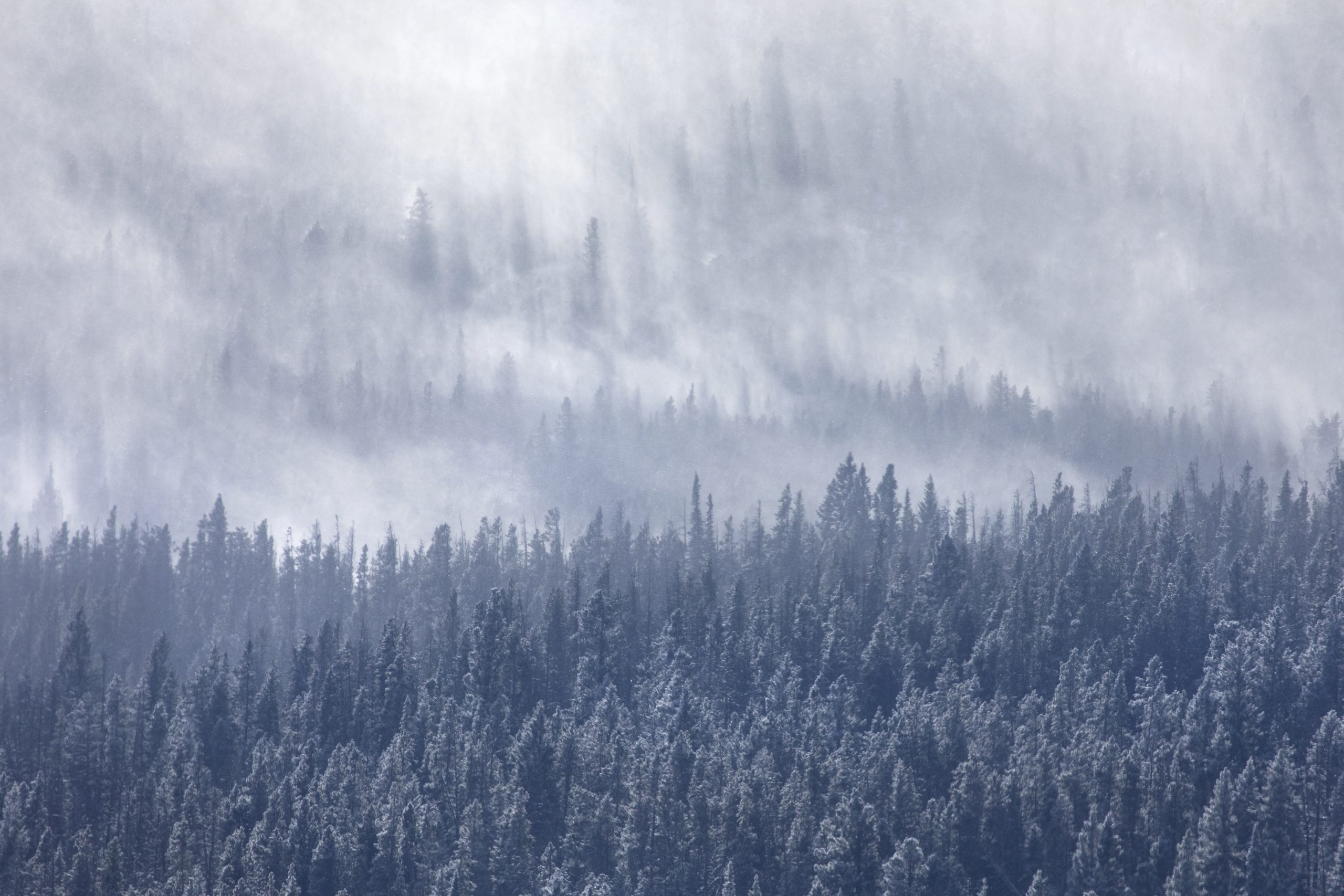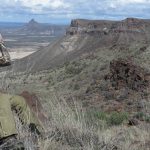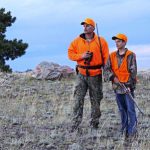Getting caught out in an unexpected snowstorm, whether you’re on foot or in a vehicle, is no joke.
Photo above: Winter is a beautiful time of year, but getting stuck in a white-out can be deadly. Photo by Vic Schendel
Snowstorms can blow in fast and hard. In the mountains, thick, wind-driven snowfalls can quickly cut visibility to a few yards or less. Travel–whether on foot, horseback, or even in a vehicle–can be slow, dangerous, or completely halted. Trails and roads become impassable. It’s very easy to get lost, even in familiar country, and if not lost, then simply stranded and forced to survive the harsh elements.
On the plains, screaming winds can blow snow more sideways than down. There are fresh-snowfall blizzards and blizzards of whipped-up ground snow, and often there is a mixture of both. “Pouderies,” they called these terrible white-outs in the Old West fur-trapper days. There are also “northers,” sudden wind-blasts that seem to appear out of nowhere and turn snow crystals into blinding pellets. Steep temperature drops, severe windchill factors, and a lack of protective cover add to both the misery and danger of being “caught out” in open country.
From autumn into winter, in the mountains and on the plains, snowstorms are responsible for a high percentage of search-and-rescue efforts involving lost or stranded hunters. Most of these hunters end up enduring some pretty grueling ordeals before they are rescued. And of course, some don’t make it. A few hunters survive the experience in pretty good shape. These are the comparative minority who started out well-prepared for a possible snowstorm emergency, and who knew what to do when it occurred.
Although anyone can be surprised and overtaken by a sudden storm, it’s worth noting that often, dangerous snowfall blasts announce their approach well ahead of arrival. Not only does the sky show signs of an incomer, but the storm itself might appear in subtle or obviously progressive stages. Smart hunters maintain an alert weather eye and read environmental clues–such as thickening or darkening clouds (especially those showing increased vertical height and blackened, roiling bottoms), changes in the direction or force of the wind, signs of a falling barometer, and of course the first, possibly light appearance of snowflakes. By accurately reading the weather you can sometimes get a jump on storm arrival and either head immediately for safety or at least locate the best possible place to hunker down and withstand the storm’s brunt and duration.
But let’s say for one reason or another you are caught out, and suddenly realize a bad storm is roaring in, or perhaps has already hit. The initial and vitally important decision is: Should you try to push on anyway, braving the elements while staggering toward ostensible safety, or should you shelter up and ride it out? The best choice depends entirely on the specific situation, but more often than not it’s a mistake to flounder on in low-visibility, high-danger conditions. Too many bad things can happen, and your chances of getting lost, exhausted, frostbitten, hypothermic, or outright killed rise substantially. The exception would be when you know for certain that safety can be reached with a comparatively short, physically plausible effort. Otherwise, at the first sign that you’re caught in a serious storm, it’s generally best to shift into survival mode.
Step one is to survey the surroundings. Where and how can you escape, or at least minimize the brunt of the elements? In a snowstorm this means getting out of the wind and staying or becoming dry. Wind chills can be deadly, and even an imperfect windbreak makes a difference. With any increase in wind exposure, the rate of personal heat loss is exponential. For example, an 8 mph wind whisks away four times more body heat than a 4 mph wind. As for the effect of moisture, you can lose body heat as much as 30 times faster if your skin and clothing are wet. So the need to avoid wind and stay dry is paramount.
Natural windbreaks include thick copses of trees, hollows beneath large conifers, large boulders or rock formations, caves, ravines and (in open country) any kind of trench-like “cut,” coulee, or arroyo. The very best sites are also close to a source of firewood or other easily gathered fuel.
In some circumstances, once you find a good natural windbreak, there will be time and materials to fashion an emergency shelter. In other cases the best you can do is get out of the wind and wrap up in whatever air-and-moisture barrier you have on hand. This could be a tarp, space blanket, hooded parka, rainsuit, heavy-plastic trash bag, and so on. Insulation of various kinds (dry dead leaves, grasses, man-made materials) can be stuffed inside the wrap and also inside your clothing to help retain warmth.
In very open country, such as the northern plains, the only way out of the wind might be by digging a deep, narrow trench in the snow, lining its bottom with whatever insulating or water-resistant materials are on hand, and lying down inside, literally beneath the blowing storm, while you wait for it to pass over. This is hardly pleasant, but many people, including plains Indians and frontiersmen, used the tactic to survive when other, less savvy individuals stayed above ground and perished.
In any type of terrain, if you locate a good wind-and-snow-break and have ample fire fuel on hand, you can survive a storm simply by building a large fire (making it longer, not taller, to warm more of your body) and positioning yourself between the fire and a heat-reflecting surface such as a boulder, rock wall, or the metallic side of a space blanket.
When time and materials allow, the optimal strategy is to fashion an emergency shelter, especially one combined with a warming fire. Shelter-making is a huge subject, but a few basic tips can be helpful. First, unless you’ve trained in shelter building, go for the simplest possible construction. One example is the basic lean-to. Start with two sturdy 3- to 4-foot sticks sharpened and driven into the ground on an angle so that they cross at the top, forming a V. Then use a 6- to 8-foot stick/branch for a ridgepole, resting one end inside the V, angling the remaining length down to the ground. Lash these tight if possible. A tarp or space blanket can be draped over this frame and pegged down to make an open-faced shelter (facing away from the wind). Seal the base area, where the tarp meets the ground, with packed snow. Additional snow can be packed up the walls to aid insulation. (Lacking a tarp, layer in branches, conifer boughs, and other natural materials to form the sides and top of the shelter, then seal everything off with a tight packing of snow.) The ground inside the shelter should be insulated with whatever dry material is available. If a fire can be built near the mouth of the lean-to, all the better.
For modern hunters, the dangers of a snowstorm or blizzard exist not only in the field, but also inside our motorized vehicles. Getting storm-stranded on a highway or back road can be its own kind of life-or-death survival situation. The most important thing to remember if you have to shelter in a vehicle during a snowstorm is that carbon monoxide (CO) poisoning is a real danger. About 1,500 people in America die in their cars each winter from CO poisoning, usually while stranded and running their engines and heaters to stay warm. When drifting snow (or packing from a slide-off) clogs the exhaust pipe, fumes back up and leak into the interior. Odorless CO kills people before they even realize they are being poisoned. So rule number one: check periodically to be sure your exhaust pipe is cleared of all snow.
Next, when a storm is raging, stay with your car unless help is clearly reachable. Bundle up to stay warm, and run the engine and heater in ten or fifteen minute intervals to preserve fuel. If fuel runs out, the vehicle might not remain your best shelter, but it can still be a source of lifesaving resources. A hubcap can be used to dig a snow cave or trench, or it can serve as a dry fire-base. Dipstick oil soaked into a rag or paper makes a good firestarter. Maps can be rolled tight to serve as kindling. Slash open seats and use the foam for insulation to be stuffed inside coats or boots. Floor mats can be wrapped around your torso, legs or feet; or they can be used as insulating, waterproof ground pads for an outdoor shelter. When cold-storm strandings are a possibility, it’s smart to prep your vehicle with a shovel, a winter-rated sleeping bag, and a pair of lightweight snowshoes for each person aboard. Add an axe and some pre-split logs in case you need to rely on an emergency outdoor fire.
When dangerous snowstorms hit, those who have the good sense to “be prepared” generally fare best, with the least misery and injury. Where I live in the Rockies, even mid-September can be snow time in the high country, and from October on, both the mountains and the plains are fair targets for northers, snow dumps, and even white-out “pouderies.”
For me, essential equipment (in addition to a standard survival kit) includes: an overkill of firestarters (matches, lighters, candle stubs, home-made tinder, commercial fire cubes, metal-match “sparking” device); a lightweight shelter tarp; at least one metallic-sided space blanket; four heavyweight yard-size plastic trash bags (for extra wind and moisture protection, vapor barriers, etc.); a large metal cup and spoon (for snow-melting water and emergency cooking); a lightweight, plastic digging tool (to aid emergency shelter-building); a 25-foot roll of parachute cord; commercial hand and foot warming packets and insoles; spare wool socks; a balaclava or similar head and neck covering; gloves and/or mittens, and a “food sack” containing high-energy protein bars, packets of dried soup and a wide-mouthed plastic bottle of energy-enhanced, extra-crunchy peanut butter. If I’m going to suffer a night or two out in a snowstorm, I’m going to suffer as comfortably as possible.











